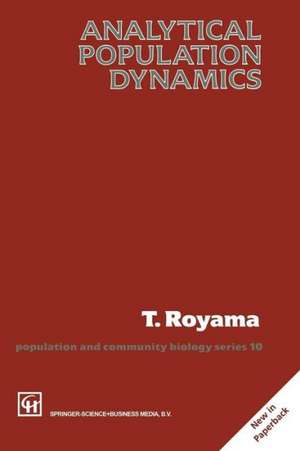Analytical Population Dynamics: Population and Community Biology Series, cartea 10
Autor T. Royamaen Limba Engleză Paperback – 31 ian 1996
Din seria Population and Community Biology Series
- 15%
 Preț: 646.11 lei
Preț: 646.11 lei - 18%
 Preț: 1224.54 lei
Preț: 1224.54 lei -
 Preț: 404.51 lei
Preț: 404.51 lei -
 Preț: 381.98 lei
Preț: 381.98 lei -
 Preț: 396.62 lei
Preț: 396.62 lei -
 Preț: 393.13 lei
Preț: 393.13 lei -
 Preț: 382.95 lei
Preț: 382.95 lei - 5%
 Preț: 373.47 lei
Preț: 373.47 lei - 18%
 Preț: 1224.36 lei
Preț: 1224.36 lei -
 Preț: 383.71 lei
Preț: 383.71 lei - 24%
 Preț: 1045.10 lei
Preț: 1045.10 lei - 24%
 Preț: 1033.08 lei
Preț: 1033.08 lei - 18%
 Preț: 1228.62 lei
Preț: 1228.62 lei - 18%
 Preț: 1546.05 lei
Preț: 1546.05 lei - 18%
 Preț: 959.98 lei
Preț: 959.98 lei - 18%
 Preț: 953.65 lei
Preț: 953.65 lei - 15%
 Preț: 635.80 lei
Preț: 635.80 lei - 18%
 Preț: 950.52 lei
Preț: 950.52 lei - 18%
 Preț: 834.17 lei
Preț: 834.17 lei - 15%
 Preț: 644.95 lei
Preț: 644.95 lei -
 Preț: 405.66 lei
Preț: 405.66 lei -
 Preț: 391.99 lei
Preț: 391.99 lei - 18%
 Preț: 1236.19 lei
Preț: 1236.19 lei - 15%
 Preț: 637.78 lei
Preț: 637.78 lei -
 Preț: 383.93 lei
Preț: 383.93 lei -
 Preț: 397.38 lei
Preț: 397.38 lei - 15%
 Preț: 640.06 lei
Preț: 640.06 lei
Preț: 1221.38 lei
Preț vechi: 1489.49 lei
-18% Nou
Puncte Express: 1832
Preț estimativ în valută:
233.72€ • 249.92$ • 194.86£
233.72€ • 249.92$ • 194.86£
Carte tipărită la comandă
Livrare economică 18 aprilie-02 mai
Preluare comenzi: 021 569.72.76
Specificații
ISBN-13: 9780412755705
ISBN-10: 041275570X
Pagini: 371
Ilustrații: XVI, 371 p.
Dimensiuni: 155 x 235 x 21 mm
Greutate: 0.55 kg
Ediția:Softcover reprint of the original 1st ed. 1992
Editura: SPRINGER NETHERLANDS
Colecția Springer
Seria Population and Community Biology Series
Locul publicării:Dordrecht, Netherlands
ISBN-10: 041275570X
Pagini: 371
Ilustrații: XVI, 371 p.
Dimensiuni: 155 x 235 x 21 mm
Greutate: 0.55 kg
Ediția:Softcover reprint of the original 1st ed. 1992
Editura: SPRINGER NETHERLANDS
Colecția Springer
Seria Population and Community Biology Series
Locul publicării:Dordrecht, Netherlands
Public țintă
ResearchCuprins
One Theoretical Bases of Population Dynamics.- 1 Basic properties and structure of population processes.- 2 Structures and patterns of population processes.- 3 Statistical analysis of population fluctuations.- 4 Population process models.- Two Analysis of Classic Cases.- 5 Analysis of the lynx 10-year cycle.- 6 Snowshoe hare demography.- 7 Density effects on the dynamics of a single-species population: Utida’s experiments on the azuki bean weevil.- 8 Dynamics of a host—parasitoid interaction system: Utida’s experimental study.- 9 Dynamics of the spruce budworm outbreak processes.- Epilogue.- References.- Author Index.
Recenzii
Reviews from the hardback: ...an exciting journey through Dr Royama's wide experience ... - Bulletin of Mathematical Biology; ...of interest to a wide range of applied and theoretical biologists. - Ethology, Ecology and Evolution; ... Part I is interesting and highly readable. I have no reservations about Part II of Royama's book. In it, he presents a marvelous review of four classic studies of population dynamics: the Canadian lynx, the snowshoe hare, Utida's experiments on the azuki bean weevil (including, in a separate chapter, the interaction with the braconid wasp), and the spruce budworm. Royama reveals himself to be practical and generaly non-dogmatic in his approach to modelling. As in Part I, his writing is lively. Overall, I recommend this book - particularly Part II - to anyone interested in modelling the dynamics of biological populations with the following proviso - Ecology














